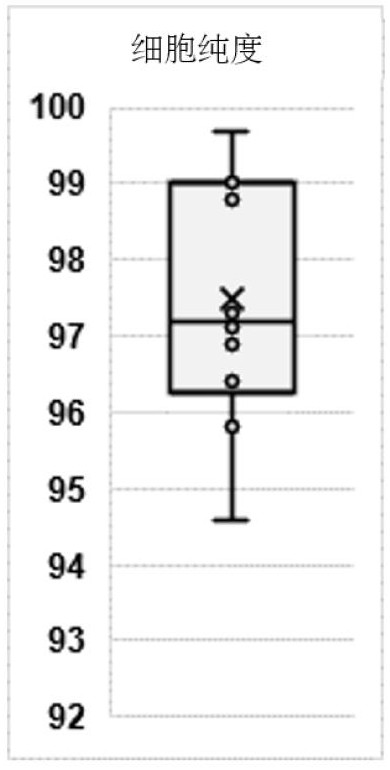A kind of spleen-regulated B lymphocyte and its preparation method and application
A technology of B lymphocytes and spleen cells, applied in the field of cell biology, can solve problems such as glomerulonephritis and interstitial fibrosis that cannot be universally applied, and achieve good therapeutic potential, reduced thinning, and tubulointerstitial fibrosis lessening effect
- Summary
- Abstract
- Description
- Claims
- Application Information
AI Technical Summary
Problems solved by technology
Method used
Image
Examples
Embodiment 1
[0037] This example provides a method for sorting the regulatory B lymphocytes positive for CD1d, CD5 and CD21 / 35 antibodies in mouse spleen.
[0038] Step 1: Harvest mouse spleen cells. Using freshly obtained mouse spleen, on ice, use pre-cooled sharp ophthalmic scissors to cut the spleen tissue into 1mm 3 Fragments were filtered through a 100 μm nylon mesh and cells were resuspended in RPMI1640 cell culture medium.
[0039] Step 2: Surface antibody-labeled mouse spleen cells. The cells obtained in step 1 were subjected to flow cytometry surface antibody staining in the Staining Buffer (eBioscience) system; staining markers: CD1d, CD5 and CD21 / 35; staining incubation conditions: room temperature, dark, 20 minutes.
[0040] Step 3: FACS sorting target cells. The cells stained in step 2 were immediately subjected to FACS cell sorting on the MoFlo XDP ultra-fast flow cytometry sorting system (Beckman Coulter) to sort CD1d, CD5 and CD21 / 35 antibody-positive regulatory B lympho...
Embodiment 2
[0043] This example provides the use of regulatory B lymphocytes in adoptive transfer to the kidney. This application involves the adoptive transfer of regulatory B lymphocytes and the tracking and observation of their distribution in the kidney.
[0044] Step 1: Obtain spontaneous red fluorescent mT / mG mouse-derived spleen CR1 + Breg cells. The sorting method of the cells is the same as that in Example 1.
[0045] Step 2: Spleen CR1 from mT / mG mice with auto red fluorescence + Adoptive transfer of Breg cells. Spleen CR1 from mT / mG mice with auto red fluorescence + The Breg cells were adoptively transferred by the left renal vein injection method.
[0046] Step 3: Detect the fluorescent signal after adoptive transfer. At 15 minutes after the injection procedure in step 2, the bilateral kidneys were exposed from the abdomen, the renal capsule was removed with microtweezers, and CR1 was observed with a two-photon microscope while keeping the animal alive. + Distribution ...
Embodiment 3
[0049] This example provides the application of regulatory B lymphocytes in kidney protection. Specifically, it relates to the application of regulatory B lymphocytes in adoptive transfer therapy for experimental renal tubulointerstitial fibrosis.
[0050] Step 1: Obtain spleen CR1 + Breg cells. The sorting method of the cells is the same as that in Example 1.
[0051] Step 2: Construction of UUO model mice. UUO model mice were obtained by unilateral ureteral ligation.
[0052] Step 3: Spleen CR1 + Adoptive transfer of Breg cells. Immediately after the ureteral ligation procedure in step 2, 5 x 10 5 CR1 + Breg cells were injected into the obstructed kidney of UUO model mice through renal vein, and gauze was used to stop bleeding for 3 minutes after injection.
[0053] Step 4: Staining observation. Step 3: On the 7th day after treatment, the obstructed side kidney of the mouse was taken, and the renal tissue paraffin pathological section was prepared, with a thickne...
PUM
| Property | Measurement | Unit |
|---|---|---|
| purity | aaaaa | aaaaa |
| purity | aaaaa | aaaaa |
| purity | aaaaa | aaaaa |
Abstract
Description
Claims
Application Information
 Login to View More
Login to View More - R&D
- Intellectual Property
- Life Sciences
- Materials
- Tech Scout
- Unparalleled Data Quality
- Higher Quality Content
- 60% Fewer Hallucinations
Browse by: Latest US Patents, China's latest patents, Technical Efficacy Thesaurus, Application Domain, Technology Topic, Popular Technical Reports.
© 2025 PatSnap. All rights reserved.Legal|Privacy policy|Modern Slavery Act Transparency Statement|Sitemap|About US| Contact US: help@patsnap.com



